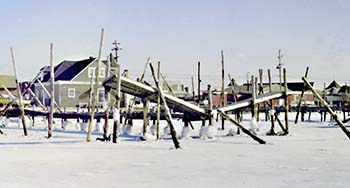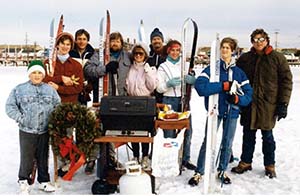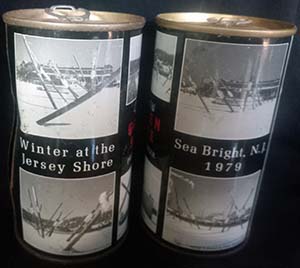
Dock damage from the “Big Freeze of 1979.”
My brother’s marina is located on a narrow part of the Shrewsbury River about four miles in from the Atlantic Ocean. There’s about a three-foot tide and the water is brackish so it will freeze, but only if temperatures stay below 20 degrees for an extended period of time. Every six or seven years we get just the right conditions so that the river freezes hard all the way across. This is opposed to the wider parts of the river where there is very little tide, and the current flows more slowly. There we’ll get good solid ice about three years out of four, much to the delight of the ice boaters. (See “On the Water” February 2019 online edition at www.lakesidenews.com.)
When we do get a hard freeze, ice will form around the pilings that support the docks. When the tide comes up, it may pull the piling about an eighth of an inch up out of the mud. When the tide goes out, the ice breaks around the piling and goes back down, where it freezes around the piling again and pulls it another eighth inch up. Repeat this every 12 hours and pretty soon all the pilings and docks will be laying on their sides at odd angles to go floating down the river as soon as the ice melts!
There are various mechanical means to keep the pilings from freezing such as pumping either air bubbles or the comparatively warm water up from the bottom of the river to keep ice from forming around the piling. This doesn’t work in our part of the river because the current runs so fast that the air bubbles or warmer bottom water would be swept away before it could get up to the ice. The only solution is to chop the ice around each piling at least once a day and pull the pieces of ice out of the water because otherwise, they will freeze back where they were.
During the winter all the casual employees at the marina have been laid off so only my father (known as the “Old Man”), my brother and myself are there to chop the ice every day.
The ice is usually an inch or two thick, so my brother and I chop it with large axes while the Old Man follows behind with his homemade “industrial strength” crab net and drags all the pieces of chopped ice out of the holes.
This is not too bad when there is no wind and the sun is shining, but usually, the temperature is in the mid-20s and there’s a 10-knot wind and cloud cover. BRRRRRR!
Once we called the State Unemployment Office and asked for four laborers. When we explained what had to be done, we were told we had to pay them for a full day’s work, no matter how long they were actually on the job. We agreed, and the next day four husky guys showed up and we all got busy chopping ice. At 10 a.m. they all took off for coffee break and that was the last we saw of them, so the three of us went back to chopping ice. I ran into one of them a few days later and asked why they didn’t even come back for their pay. He told me to keep the money, they didn’t want any part of it. He’d seen enough ice to last a lifetime.

Family and friends who gathered for a BBQ on ice during the “Big Freeze of 1979.”
One Sunday afternoon in mid-February the regular crew were all sitting around the fireplace in the bar, looking out at the frozen river. The temperature had climbed into the upper 40s, and it was brilliant sunshine. We were all suffering from “cabin fever” when someone said, “Looks like a good day for a BBQ!” That’s all it took. Someone ran down to the grocery store for hamburgers, bratwurst, and accoutrements while others dragged the BBQ and a bunch of chairs and a boombox out to the middle of the river. (We didn’t need an ice chest to keep the beer cool.)
There were about two or three inches of snow on top of the ice, so we brought along the cross-country skis. The party was in full swing when a very annoyed Marine Police Officer gingerly walked out across the ice and asked what the heck we were doing.
We explained that we were having a BBQ. He asked whether we knew that it was dangerous to be out in the middle of the river and that we were risking our lives. We pointed out that the ice was 21 inches thick, and you could safely drive a tractor-trailer across it.
He thawed out a little when we offered him a burger and beer. He said he was on duty but would be happy for a hot chocolate. He told us that the local police on one side of the river had gotten a noise complaint. (Yes, sound does travel across the ice). The Rumson police said it was not their jurisdiction and referred the call to the Sea Bright Police on the other side of the river and got the same answer. Finally, the Marine Police began getting the calls, so he, being the junior officer, had to leave the nice warm marine police station and go out to investigate. Having ascertained that there was no life-threatening situation, he thanked us for the hot chocolate and returned to his football game.

Commemorating the “Big Freeze of 1979”
The party went on for most of the afternoon and word spread so more and more people wandered out to join us. The local FM radio station began to play wintery songs dedicated to the “gang out on the ice.” Finally, the wind came up and it started to get brutally cold, so the party broke up, but people talked about the good times for weeks afterward.
When the spring thaw came, the neighboring marinas that had not chopped the ice had lost most of their pilings and in some cases entire docks. Since the marine contractors in the area were inundated with work, it took several months for some of them to get back into operation. We were happy to be carrying on business as usual.
The situation was so unique that a local brewery even issued a special beer can commemorating the “Big Freeze of 1979.” I still have a few of the beer cans as a reminder of one of the great advantages of living on Lake Lanier!
Photos: provided by Vinnie Medes




